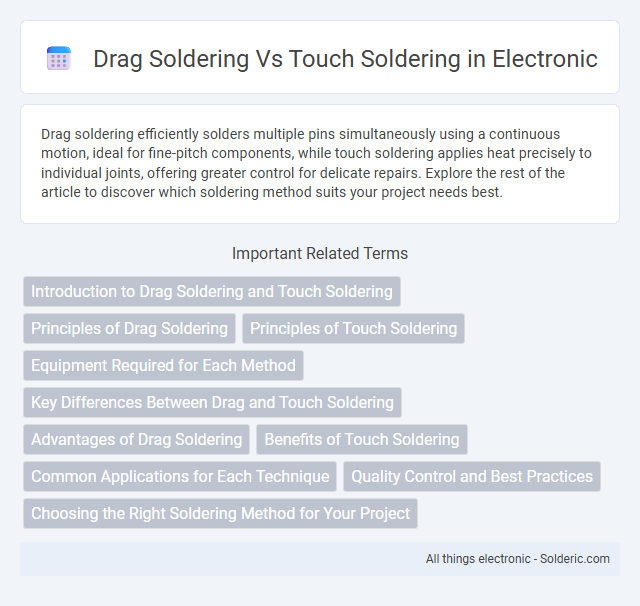Drag soldering efficiently solders multiple pins simultaneously using a continuous motion, ideal for fine-pitch components, while touch soldering applies heat precisely to individual joints, offering greater control for delicate repairs. Explore the rest of the article to discover which soldering method suits your project needs best.
Comparison Table
| Aspect | Drag Soldering | Touch Soldering |
|---|---|---|
| Definition | Technique of dragging a heated soldering iron tip with solder along component leads and PCB pads | Technique of applying solder by touching the component lead and pad with a heated soldering iron tip |
| Application | Widely used for soldering multiple pins, especially SMD ICs with fine pitch | Commonly used for single joints or through-hole components |
| Speed | Faster for multi-pin soldering | Slower, more precise for individual joints |
| Skill Level | Requires practice for steady movement and avoiding solder bridges | Basic soldering skills sufficient |
| Risk of Solder Bridges | Higher risk due to dragging motion over multiple pins | Lower risk, focused on individual joints |
| Use Case | SMD components with closely spaced pins (e.g. QFP, SOIC) | Through-hole components, discrete parts, or single leads |
| Tool Tip Type | Chisel or bevel tip preferred | Conical or pointed tip preferred |
Introduction to Drag Soldering and Touch Soldering
Drag soldering involves sliding a soldering iron tip coated with molten solder across multiple closely spaced pins, enabling efficient soldering of surface-mount components like QFPs. Touch soldering uses precise contact between the soldering iron tip and individual solder joints, ideal for delicate or single-point connections. You can choose drag soldering for speed and uniformity or touch soldering for control and accuracy in electronic assembly tasks.
Principles of Drag Soldering
Drag soldering involves moving a heated soldering tip continuously along a series of pins, allowing the molten solder to flow and create consistent joints efficiently. This technique relies on precise temperature control and the use of a specially shaped tip to maintain contact with multiple connections without bridges. The principle ensures rapid soldering with minimal thermal stress and solder waste compared to touch soldering, which targets individual joints sequentially.
Principles of Touch Soldering
Touch soldering involves applying heat directly to the joint using a soldering iron tip, allowing precise control over the temperature and placement of solder. This method relies on the principle that the solder must melt and flow onto the heated surfaces for a strong electrical and mechanical bond. You achieve optimal results by maintaining steady contact and ensuring the workpieces are clean and properly heated before applying solder.
Equipment Required for Each Method
Drag soldering requires a specialized drag soldering iron equipped with a wide, flat tip designed to heat multiple pins simultaneously, along with solder wire and flux for consistent application. Touch soldering uses a standard soldering iron with a fine-point tip to apply heat directly to individual pins, necessitating precision tools like tweezers or a solder sucker for small components. Both methods depend on quality solder wire and flux but differ significantly in tip design and handling equipment to achieve optimal solder joints.
Key Differences Between Drag and Touch Soldering
Drag soldering uses a wetted soldering iron tip to smoothly slide across multiple pins, ideal for fine-pitch surface-mount components, while touch soldering involves briefly contacting each joint individually, suitable for through-hole or discrete components. Drag soldering requires precise temperature control and a well-shaped tip to avoid bridging, whereas touch soldering relies on quick, controlled contact to minimize heat damage. The primary difference lies in the technique--drag soldering achieves efficiency and uniformity on dense arrays, while touch soldering offers accuracy for isolated or larger leads.
Advantages of Drag Soldering
Drag soldering offers significant advantages in speed and efficiency, allowing you to solder multiple pins simultaneously on fine-pitch components. This technique minimizes the risk of solder bridges and reduces heat exposure to sensitive parts compared to touch soldering. Improved consistency and reduced rework make drag soldering ideal for surface-mount technology (SMT) assembly and rework processes.
Benefits of Touch Soldering
Touch soldering offers precise heat control and minimal thermal stress, making it ideal for delicate electronic components. This method reduces the risk of solder bridges and component damage by applying heat directly and efficiently. Enhanced control during touch soldering leads to cleaner joints, improved reliability, and better overall soldering quality.
Common Applications for Each Technique
Drag soldering is commonly used for soldering multiple pins of surface-mount components such as QFPs and BGAs, where speed and precision are crucial for avoiding solder bridges. Touch soldering is favored for discrete components, through-hole leads, and rework tasks that require focused heat application and greater control to prevent damage to nearby components. Each method is selected based on the component type, board complexity, and repair or assembly requirements.
Quality Control and Best Practices
Drag soldering provides consistent solder joints by maintaining uniform heat distribution across multiple pins, reducing the risk of bridging and cold joints. Touch soldering allows for precise control on individual components, making it ideal for delicate or fine-pitch electronics, but requires skilled operators to avoid overheating or insufficient solder flow. Best practices include using the correct soldering tip, temperature setting, and applying flux appropriately to ensure optimal joint reliability and quality control.
Choosing the Right Soldering Method for Your Project
Drag soldering suits projects with closely spaced surface mount components, offering speed and efficiency by simultaneously soldering multiple pins, while minimizing solder bridges when performed correctly. Touch soldering provides precision for single joints or delicate components, ideal for repair or prototyping where control is crucial. Selecting the appropriate method depends on component layout, project complexity, and desired throughput, ensuring solder joint reliability and optimal workflow.
Drag soldering vs touch soldering Infographic

 solderic.com
solderic.com